|
|
ARTHROPODS:
Insects»
Spiders»
Centipedes»
Millipedes»
Sowbugs»
Harvestmen»
Mites
& Ticks»
Scorpions»
Identification
Tips»
About
the Critter Files»
Links» |
|
|
|
 |
LEAF-FOOTED
BUGS
& SCENTLESS PLANT BUGS
Critter
Files/Insects/True
Bugs/Leaf-footed & Scentless Plant Bugs
By Blake Newton
University of Kentucky Department of Entomology |
| |
|
| Common
Kentucky Leaf-footed Bugs: |
|
|
|
|
|
| |
|
|
|
|
|
|
|
|
|
| |
|
|
|
|
|
|
|
|
|
|
| Common
Kentucky Scentless Plant Bugs: |
|
|
|
|
|
|
|
|
|
|
|
|
|
|
|
|
| |
| TAXONOMY |
KINGDOM:
Animalia | PHYLUM: Arthropoda | CLASS: Insecta | ORDER: Hemiptera
| FAMILY: Coreidae (leaf-footed bugs) & Rhopalidae (scentless
plant bugs) |
| |
| Other
Names: Coreids, Rhopalids |
| |
WHAT
ARE LEAF-FOOTED BUGS AND SCENTLESS PLANT BUGS?
LIFE CYCLE
ECOLOGY
PEST STATUS
COMMON KENTUCKY LEAF-FOOTED BUGS
COMMON
KENTUCKY SCENTLESS PLANT BUGS
COLLECTING & PHOTOGRAPHY
LEAF-FOOTED & SCENTLESS PLANT BUG FACTS
MYTHS, LEGENDS, AND FOLKLORE |
| |
| WHAT
ARE LEAF-FOOTED BUGS & SCENTLESS PLANT BUGS? |
|
Leaf-footed
Bugs (Family Coreidae) & Scentless Plant Bugs
(Family Rhopalidae) are two similar insect families in the in the
order Hemiptera (which also includes assassin
bugs, stink bugs, and
other insects). All insects in Hemiptera share a few characteristics,
including piercing-and-sucking mouthparts, and wings (called hemielytra)
which are membranous at the tips but hardened at the base.
Leaf-footed bugs can
be difficult to distinguish from other Hemiptera, especially assassin
bugs, which are often similar in size (3/4" - 1"). In
many leaf-footed bug species, the back legs are wide and leaf-like
in shape, but this is not true for all species, including some common
varieties like the squash bug. Often,
the only way to determine the identity of a leaf-footed bug is with
a microscope: leaf-footed bugs have 4-segmented beaks, assassin
bugs have 3-segmented beaks.
Scentless
plant bugs are similar to leaf-footed bugs. In fact, some
scientists and field guides place scentless plant bugs in the leaf-footed
bug family. But scentless plant bugs are usually much smaller:
rhopalids found in Kentucky are less than 1/2" long.
|
|
| SIZE:
Leaf-footed bugs up to 1", Scentless Plant Bugs up to 1/2" |
| |
| LIFE
CYCLE |
|
Like
all Hemiptera, leaf-footed bugs and scentless plant bugs go through
a simple metamorphosis with egg, nymph, and adult stages. Females
of most species lay eggs during warm months. The eggs are
often stuck to leaves or branches, or hidden under bark, depending
on the species. After hatching, the wingless nymphs molt several
times before becoming full-sized, winged adults. The adults
will often mate and reproduce numerous times during the growing
season. Large nymphs or adults are usually the overwintering
stage. |
| |
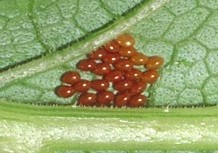
Squash bug eggs (R. Bessin, 2000) |

Typical Leaf-footed Bug Nymph (R. Bessin,
2000) |
| |
| ECOLOGY |
|
| |
There are
several species of leaf-footed bugs and scentless plant bugs in
Kentucky. They are all believed to be herbivores: they use their piercing-and-sucking
mouthparts to feed on plant juices. Many are able to feed
on a variety of plants, including crop and garden species. (A few sources, including field guides and and websites, mention that some leaf-footed bugs are predatory, but modern experts believe that
this is probably not true).
Like stink
bugs, leaf-footed bugs are able to secrete foul-smelling, foul-tasting
fluids from pores on the sides of their bodies. These secretions
help to protect leaf-footed bugs from predators. Nevertheless,
leaf-footed bugs are often eaten by birds, spiders, assassin bugs,
and other predators. Scentless plant bugs, as their name suggests,
do not have scent glands. |
| PEST
STATUS |
|
Although
several species of leaf-footed bugs can be pests, Kentucky has only
one important leaf-footed bug pest, the Squash
Bug, Anasa tristis. The only pest scentless plant
bug in Kentucky is the Boxelder Bug. Both
of these insects are discussed in detail below.
|
| |
| |
| COMMON
KENTUCKY LEAF-FOOTED BUGS |
|
|
SQUASH
BUG
GENUS and SPECIES:
Anasa tristis
The Squash Bug,
Anasa tristis, feeds on squash, cucumbers, and related
plant species. It can be found throughout the growing season
on these plants. The eggs of the squash
bug are pictured above. Squash bugs are about 17 mm when full
grown.
|
| |
 Squash
Bug (R. Bessin, 2000)
Squash
Bug (R. Bessin, 2000) |
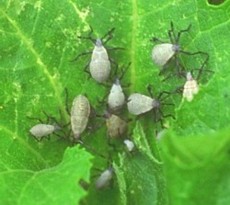 Squash
Bug Nymphs (R. Bessin, 2000)
Squash
Bug Nymphs (R. Bessin, 2000) |
|
|
|
HORNED
SQUASH BUG
GENUS and SPECIES:
Anasa armigera
Pictured below is Anasa
armigera, the Horned Squash Bug. This
leaf-footed bug resembles the squash bug in both behavior and appearance,
and is sometimes a pest of pumpkins and similar vegetables. It
is encountered less frequently than the common squash bug, and differs
in having two small "horns" at the base of each antennae. |
| |
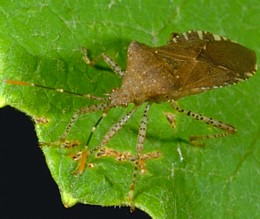 Horned
Squash Bug (R. Bessin, 2000)
Horned
Squash Bug (R. Bessin, 2000) |
|
|
|
WESTERN
CONIFER SEED BUG
GENUS
and SPECIES: Leptoglossus occidentalis
Below is a common leaf-footed
bug, the Western Conifer Seed Bug, Leptoglossus
occidentalis. A serious pest west of the Rockies, this species
occasionally causes damage in conifer seed production operations in
Kentucky and other states. |
| |
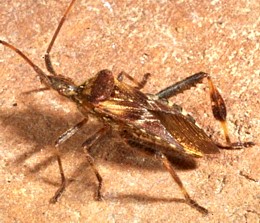 Leptoglossus
occidentalis (R. Bessin, 2000)
Leptoglossus
occidentalis (R. Bessin, 2000) |
|
|
|
EUTHOCHTHA
GALEATOR
GENUS
and SPECIES: Euthochtha galeator
Pictured
below is Euthochtha galeator, a plant-feeding
leaf-footed bug species commonly found in fields, fence rows, and
similar habitats. It grows to about 17 mm in length. |
| |
 Euthochtha
galeator (R. Bessin, 2000)
Euthochtha
galeator (R. Bessin, 2000) |
|
|
|
ACANTHOCEPHALA
TERMINALIS
GENUS
and SPECIES: Acanthocephala terminalis
Below is Acanthocephala
terminalis, a large (2 cm) leaf-footed bug with distinctive
orange-tipped antennae. It is common in meadows and other sunny,
weedy habitats. |
| |
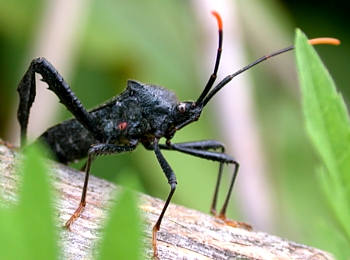 Acanthocephala
terminalis (B. Newton, 2003)
Acanthocephala
terminalis (B. Newton, 2003) |
|
| |
| COMMON
KENTUCKY SCENTLESS PLANT BUGS |
|
|
| |
BOXELDER
BUG
GENUS
and SPECIES: Boisea trivittatus
The
familiar Boxelder Bug, Boisea trivittatus,
pictured below, is Kentucky's only pest scentless plant bug. This
distinctive bug feeds on boxelder trees and other plants. It
usually does not cause significant damage to the trees, but it will
sometimes enter homes in the fall in large numbers. It is harmless
to humans. Read
more about pest boxelder bugs in our Boxelder
Bug ENTFact.
|
| |
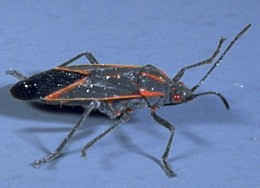 Boxelder
Bug (R. Bessin, 2002)
Boxelder
Bug (R. Bessin, 2002) |
|
| |
| COLLECTING
& PHOTOGRAPHY |
|
Leaf-footed bugs are
fairly common, and can be found on summer and fall days in gardens,
crops, weeds, trees, and other vegetation. In particular,
squash bugs are very commonly found underneath the leaves of squash
plants and related garden plants.
Some leaf-footed bugs
have unique appearances, and make nice photo subjects or additions
to an insect collection. Like many Hemiptera, leaf-footed
bugs and scentless plant bugs are normally slow moving and do not
fly very often, so they are easy to capture and photograph.
Other than boxelder bugs,
which are often very common, scentless plant bugs are not as common
as leaf-footed bugs. Sampling tall weeds with a sweep net
will occasionally yield members of this family.
|
| |
| LEAF-FOOTED
& SCENTLESS PLANT BUG FACTS |
|
Some leaf-footed bugs
have very unusual back legs. Here is a striking
example from Paraguay on the "God of Insects" site.
|
| |
| MYTHS
- LEGENDS - FOLKLORE |
|
Do you know any myths,
legends, or folklore about leaf-footed or scentless plant bugs?
Let us know if you do!
|
Original document: 25 May 2004
Last updated: 25 May 2012
Photos courtesy R. Bessin and B. Newton, University of Kentucky
The Kentucky Critter
Files are maintained by Blake Newton, Department of Entomology, University
of Kentucky.
Contact: blaken@uky.edu
|
|

